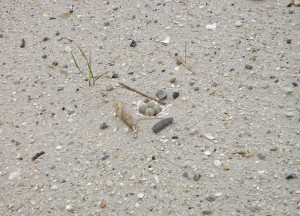The Great Piping Plover Nest Search
An Insider’s Perspective
By Christoper Haxter, Field Technician

Here on the Conserve Wildlife Foundation blog we have talked a lot about piping plovers and the conservation efforts we enact when we find a nest. But have you ever wondered how we locate their nests? The key is knowing where to look. This is my second summer working on the beach nesting bird project and this year I have been able to observe a behavior which I had only heard about the year before. Piping plovers return to the same breeding site year after year, a behavior called site fidelity.
Plovers Evolved to Nest on the Beach
This behavior is thought to help maintain the adaptation of a population to a very specific environment. In this case the piping plovers have evolved to nesting on the beach and those that nest elsewhere may not be successful. Natural selection favors the birds who exhibit site fidelity. Another benefit to this behavior comes at the beginning of the nesting season. When the plovers return to the same spot they spend less time fighting with other plovers over territory. When a nest is destroyed or predated, it takes time to re-nest; so those plovers that nest sooner have a greater chance at fledging chicks.
Some plovers are more exact than others in returning to the same spot. Down on Stone Harbor Point, the area I am most familiar with, we have had a plover nest in the exact same place for at least three years now. The marks from our nest exclosure (cages) are still visible in the sand, and year after year we have found a nest right in the middle. Unfortunately we can’t know for sure that the same bird is nesting on that spot. We may be able to recognize its behavior (yes some piping plovers have a distinctive personality), but the only way to be positive is if the plover was banded, and very few are.

Protecting Nests During Breeding Season
The breeding sites that the plovers return to year after year are the areas we fence off each spring to protect them during the breeding season. Knowing the breeding site greatly narrows down the areas to be searched, but there is still a lot of beach to look over. The most efficient way to search an area is to mentally break it down into a grid, this way we can search the entire area without any overlap. You may have seen us walking through the fenced areas doing a nest search. Sometimes the birds alert us to the nest location, sometimes they don’t. Which is why it is so important to stay out of the fenced area, a nest could be anywhere and they are very hard to see.
We also stay hopeful and search in new areas that have suitable nesting habitat, or where they have nested in years past. This year we discovered a nest in Ocean City, where we haven’t had a nest for some time. Sometimes it is hard to believe all the work that goes into helping these tiny birds, but it’s nothing compared to the work the plovers do for their chicks. They have to fight off predators, and deal with flooding, heat, and storms. This is hard enough without human disturbances, which is a relatively new threat to them if you look at the big picture. Hopefully the piping plover will keep its strong will to survive, and we’ll be there to help when things get too difficult.
Leave a Comment
How many nests were left at the Point after predation and tidal flooding?
Was there twice and could not tell – did see a bird or two at waterline.
Carol, This response is from Todd Pover:
“There were 10 pairs of Piping Plovers at Stone Harbor Point this year. Only three hatched young, of those four chicks successfully survived to fledgling (flying) stage. This translates to a productivity of 0.40 chicks per pair, well below our recovery goal and the level believed necessary to sustain the population (1.50 and 1.25 chicks per pair, respectively).”
Comments are closed.